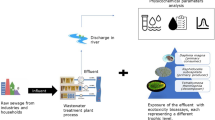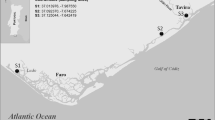Abstract
The aim of this study was to assess the ecotoxicological effects of water coming from untreated organic and conventional rice field production areas in the Ebro Delta (Catalonia, Spain) treated with the herbicides oxadiazon, benzofenap, clomazone and bensulfuron-methyl and the fungicides carbendazim, tricyclazole and flusilazole. Irrigation and drainage channels of the study locations were also included to account for potential toxic effects of water coming in and out of the studied rice fields. Toxicity tests included four species (Pseudokirchneriella subcapitata, Desmodesmus subcapitatus, Chlorella vulgaris and Daphnia magna), three endpoints (microalgae growth, D. magna mortality and feeding rates), and two trophic levels: primary producers (microalgae) and grazers (D. magna). Pesticides in water were analyzed by solid phase extraction-liquid chromatography-electrospray-tandem mass spectrometry (LC-ESI-MS/MS). Negative effects on algae growth and D. magna feeding rates were detected mainly after application of herbicides and fungicides, respectively, in the conventional rice field. Results indicated that most of the observed negative effects in microalgae and D. magna were explained by the presence of herbicides and fungicides. The above mentioned analyses also denoted an inverse relationship between phytoplankton biomass measured as chlorophyll a and herbicides. In summary, this study indicates that in real field situations low to moderate levels of herbicides and fungicides have negative impacts to planktonic organisms and these effects seem to be short-lived.



Similar content being viewed by others
References
APHA-AWWA-WEF (1995) Standard methods for the examination of water and wastewater, 19th edn. American Public Association/America Water Works Association/Water Environment Federation, Washington, DC
Armbrust KL (2000) Pesticide hydroxyl radical rate constants: measurements and estimates of their importance in aquatic environments. Environ Toxicol Chem 19(9):2175–2180 APHA
ASTM (1998) Standard methods for the examination of water and wastewater, 20th edn. American Public Health Association, Washington, DC
Barata C, Baird D (2000) Determining the ecotoxicological mode of action of chemicals from measurements made on individuals: results from instar-based tests with Daphnia magna Straus. Aquat Toxicol 48(2–3):195–209
Barata C, Baird DJ, Nogueira AJA, Soares AMVM, Riva MC (2006) Toxicity of binary mixtures of metals and pyrethroid insecticides to Daphnia magna Straus. Implications for multi-substance risks assessment. Aquat Toxicol 78:1–14
Barata C, Damásio JB, López MA, Kuster M, López de Alda M, Barceló D (2007) Combined use of biomarkers and in situ bioassays in Daphnia magna to monitor environmental hazards of pesticides in the field. Environ Toxicol Chem 26:370–379
Barata C, Alañón P, Gutierrez-Alonso S, Riva MC, Fernández C, Tarazona JV (2008) A Daphnia magna feeding bioassay as a cost effective and ecological relevant sublethal toxicity test for environmental risk assessment of toxic effluents. Sci Total Environ t405:78–86
Bosch C, Olivares A, Faria M, Navas JM, Olmo I, Grimalt JO, Piña B, Barata C (2009) Identification of water soluble and particle bound compounds causing sublethal toxic effects. A field study on sediments affected by a chlor-alkali industry. Aquat Toxicol 94:16–27
Claver A, Peña O, Rodríguez L, Ovelleiro JL (2006) Study of the presence of pesticides in surface waters in the Ebro river basin (Spain). Chemosphere 64(9):1437–1443
Cuppen JGM, Van den Brink PJ, Camps E, Uil KF, Brock TCM (2000) Impact of the fungicide carbendazim in freshwater microcosms. I. Water quality, breakdown of particulate organic matter and responses of macroinvertebrates. Aquat Toxicol 48:233–250
Damásio J, Tauler R, Teixido E, Rieradevall M, Prat N, Riva MC, Soares AMVM, Barata C (2008) Combined use of biomarkers and in situ bioassays in Daphnia magna to monitor environmental hazards of pesticides in the field. Aquat Toxicol 87:310–320
De Lorenzo ME, Taylor LA, Lund SA, Pennington PL, Strozier ED, Fulton MH (2002) Toxicity and bioconcentration potential of the agricultural pesticide endosulfan in phytoplankton and zooplankton. Arch Environ Contam Toxicol 42:173–181
FAO and United Nations (1989) Expert group on pesticide residues. Geneva, 18–27 Oct
Fernández-Casalderrey A, Andreu-Moliner E (1994) Effect of sublethal concentrations of pesticides on the feeding behaviour of Daphnia magna. Ecotoxicol Environ Saf 27:82–89
Fernández-Valiente E, Quesada A (2004) A shallow water ecosystem: rice-fields. The relevance of cyanobacteria in the ecosystem. Limnetica 23(1–2):95–108
Fores E, Comín FA (1987) Chemical characteristics of the water in the rice fields of the Ebro delta (N.E. Spain). Arch Hydrobiol 11(1):15–24
Fores E, Comín FA (1992) Ricefields, a limnological perspective. Limnetica 8:101–109
Gustafsson K, Blidberg E, Elfgren IK, Hellstrom A, Kylin H, Gorokhova E (2010) Direct and indirect effects of the fungicide azoxystrobin in outdoor brackish water microcosms. Ecotoxicology 19:431–444
Hamilton DJ, Ambrust A, Dieterle RM, Felsot AS, Harris CA, Holland PT, Katayama A, Kurihara N, Linders J, Unsworth J, Wong SS (2003) Regulatory limits for pesticide residues in water (IUPAC Technical report). Pure Appl Chem 75(8):1123–1155
Hansen B, Alroe HF, Kristensen ES (2001) Approaches to assess the environmental impact of organic farming with particular regard to Denmark. Agric Ecosyst Environ 83:11–26
Häring AM, Dabbert S, Aurbacher J, Bicher B, Eichert C, Gambelli D, Lampkin N, Offermann F, Olmos S, Tuson J, Zanoli R (2004) Organic farming and measures of European agricultural policy. Organic Farming in Europe: Economics and Policy 11
Hildebrandt A, Lacorte S, Barceló D (2007) Assessment of priority pesticides, degradation products, and pesticide adjuvants in groundwaters and top soils from agricultural areas of the Ebro river basin. Anal Bioanal Chem 387(4):1459–1468
Hildebrandt A, Lacorte S, Barceló D (2009) Occurrence and fate of organochlorinated pesticides and PAH in agricultural soils from the Ebro river basin. Environ Contam Toxicol 57:247–255
Hogendoorn EA, Westhuis K, Dijkman E, Heusinkveld HAG, Chamraskul P, Biadul P, Baumann RA, Cornelese AA, Van Der Linden MA (2000) Determination of carbendazim in water, soil and sediment samples by RPLC with and without column switching and various spectrometric detection modes. Int J Environ Anal Chem 78(1):67–85
Hole DG, Perkins AJ, Wilson JD, Alexander IH, Grice EAD (2005) Does organic farming benefit biodiversity? Biol Conserv 122:113–130
Ibáñez C, Prat N (2003) The environmental impact of the Spanish National Hydrological Plan on the lower Ebro river and delta. Water Res Dev 19(3):485–500
Ibáñez C, Curcó A, Riera X, Ripoll I, Sánchez C (in press) Influence on birds of rice field management practices during the growing season: a review and an experiment. Waterbirds
Jeffrey S, Humphrey G (1975) New spectrophotometric equations for determining chlorophylls a, b, c, and c1 in higher plants, algae and natural phytoplankton. Biochem Physiol 167:191–194
Junghans M, Backhaus T, Faust M, Scholze Mc, Grimme LH (2006) Application and validation of approaches for the predictive hazard assessment of realistic pesticide mixtures. Aquat Toxicol 76:93–110
Kuster M, de Alda MJL, Barata C, Raldúa D, Barceló D (2008) Analysis of 17 polar to semi-polar pesticides in the Ebro river delta during the main growing season of rice by automated on-line solid-phase extraction-liquid chromatography-tandem mass spectrometry. Talanta 75:390–401
Lacorte S, Guiffard I, Fraisse D, Barceló D (2000) Broad spectrum analysis of 109 priority compounds listed in the 76/464/CEE Council Directive using solid phase extraction and GC-EI/MS. Anal Chem 72(7):1430e1440
Lesser M (1996) Elevated temperatures and ultraviolet radiation cause oxidative stress and inhibit photosynthesis in symbiotic dinoflagellates. Limnol Oceanogr 41(2):271–283
Liess M, Von der Ohe C (2005) Analyzing effects of pesticides on invertebrate communities in streams. Environ Toxicol Chem 24:954–965
Ma J, Zheng R, Xu L, Wang S (2002) Differential sensitivity of two green algae, Scenedesmus obliqnus and Chlorella pyrenoidosa, to 12 pesticides. Ecotoxicol Environ Saf 52(1):57–61
Mañosa S, Mateo R, Guitart R (2001) A review of the effects of agricultural and industrial contamination on the Ebro delta biota and wildlife. Environ Monit Assess 71:187–205
Marques C, Pereira R, Gonçalves F (2009) Using earthworm avoidance behaviour to assess the toxicity of formulated herbicides and their active ingredients on natural soils. J Soil Sediment 9:137–147
Mc William RA, Baird DJ (2002) Post-exposure feeding depression: a new toxicity endpoint for use in laboratory studies with Daphnia magna. Environ Toxicol Chem 21:1198–1205
Nicosia S, Collison C, Lee P (1991) Bensulfuron methyl dissipation in California rice fields, and residue levels in agricultural drains and the Sacramento river. Environ Toxicol Chem 47:131–137
OECD (2002) Guideline for testing of chemicals. Proposal for updating guideline 201, freshwater alga and cyanobacteria, growth inhibition test
OECD/OCDE (2004) Guideline for testing of chemicals Daphnia sp acute immobilisation test 202
Okamoto Y, Fisher RL, Armbrust KL, Peter J (1998) Surface water monitoring survey for bensulfuron methyl applied in paddy fields. J Pestic Sci 23:235–240
Osmond CB (1981) Photorespiration and photoinhibition; some implications for the energetic of photosynthesis. Biochem Biophys Acta 639:77–98
Prado R, García R, Rioboo C, Herrero C, Abalde J, Cid A (2009) Comparison of the sensitivity of different toxicity test endpoints in a microalgae exposed to the herbicide paraquat. Environ Int 35(2):240–247
Quayle WC, Oliver DP, Zrna S (2006) Field dissipation and environmental hazard assessment of clomazone, molinate, and thiobencarb in Australian rice culture. J Agric Food Chem 54:7213–7220
Relyea R, Hoverman J (2006) Assessing the ecology in ecotoxicology: a review and synthesis in freshwater systems. Ecol Lett 9(10):1157–1171
Sabater C, Carrasco JM (2001) Effects of pyridaphenthion on growth of five fresh water species of phytoplankton. A laboratory study. Chemosphere 44:1775–1781
Sancho F, Andreu-Molier E (1996) Chronic toxicity of fenitrothion to an algae (Nannochloris oculata), a rotifer (Brachionus calyciflorus), and the cladoceran (Daphnia magna). Ecotoxicol Environ Saf 35:112–120
Slijkerman DME, Baird DJ, Conrad A, Jak RG, van Straalen NM (2004) Assessing structural and functional plankton responses to carbendazime toxicity. Environ Toxicol Chem 23:455–462
Sommer U, Sommer F, Santer B, Zollner E, Jurgens K, Jamieson C, Boersma M, Gocke K (2003) Daphnia versus copepod impact on summer phytoplankton: functional compensation at both trophic levels. Oecologia 135:639–647
Tarazona JV, Sanchez P (2006) Development of an innovative conceptual model and a tiered testing strategy for the ecological risk assessment of rice pesticides. Paddy Water Environ 4(1):1611–2490
Terrado M, Barceló D, Tauler R (2006) Identification and distribution of contamination sources in the Ebro river basin by chemometrics modelling coupled to geographical information systems. Talanta 70:691–704
Tomlin CDS (2009) The pesticide manual, a world compendium, 15th edn. Crop Protection Publications, Farnham, Surrey, UK
Van den Brink PJ, Hattink J, Bransen F, Van Donk E, Brock TCM (2000) Impact of the fungicide carbendazim in freshwater microcosms. II. Zooplankton, primary producers and final conclusions. Aquat Toxicol 48:251–264
Van den Brink PJ, Hattink J, Bransen F, Van Donk E, Brock TCM (2002) Effects of a mixture of two insecticides in freshwater microcosms: II. Responses of plankton and ecological risk assessment. Ecotoxicology 11:165–180
Van Wijngaarden RPA, Crum SJH, Decraene K, Hattink J, Van Kammen A (1998) Toxicity of Derosal® (active ingredient carbendazim) to aquatic invertebrates. Chemosphere 37:673–683
Zanella R, Primel EG, Machado SLO, Gonçalves FF, Marchezan E (2002) Monitoring of the herbicide clomazone in environmental water samples by solid-phase extraction and high performance liquid chromatography with ultraviolet detection. Chromatographia 55:573–577
Zar JH (1996) Biostatistical analysis. Prentice-Hall International, Inc, New Jersey
Acknowledgments
This study was carried out with the financial support of the Spanish Ministry of Environment and the Catalan Water Agency (ACA), Department of Environment, Government of Catalonia (MOBITROF project). We thank for field and laboratory assistance to Mireia San Lorenzo, David Mateu and Lluís Llornet. We are grateful to Rafael Verdiell and Riet Vell S.A. (owners of the rice fields) for their collaboration. We also thank Katherine Sharpe for helping to improve the English and providing useful comments on a previous version of the manuscript.
Author information
Authors and Affiliations
Corresponding author
Rights and permissions
About this article
Cite this article
Suárez-Serrano, A., Ibáñez, C., Lacorte, S. et al. Ecotoxicological effects of rice field waters on selected planktonic species: comparison between conventional and organic farming. Ecotoxicology 19, 1523–1535 (2010). https://doi.org/10.1007/s10646-010-0537-5
Accepted:
Published:
Issue Date:
DOI: https://doi.org/10.1007/s10646-010-0537-5




